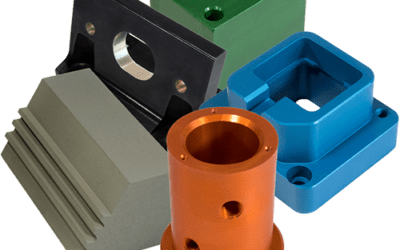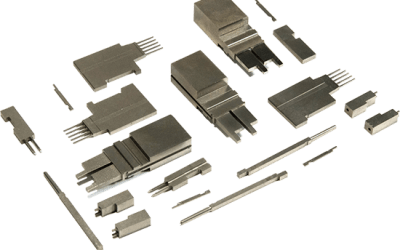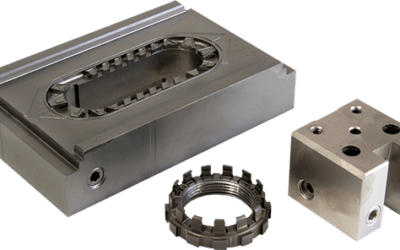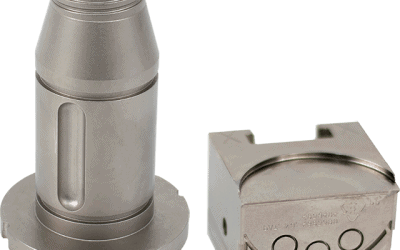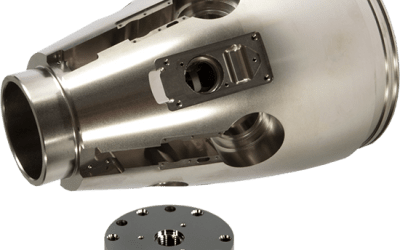Understanding Electroless Nickel Plating

PFI – The Electroless Nickel Plating Experts
Over the last thirty years, PFI has solidified itself as one of the top electroless nickel plating suppliers throughout the United States with a specialized focus on tight tolerance plating work for engineering applications, tooling protection, and other projects. This position at the forefront of the industry did not happen by accident and is a culmination of PFI’s dedication, experience, and continual advancement. Electroless nickel plating is a revolutionary plating technique that does not require a costly influx of electrical current and instead is an auto-catalytic reaction that relies upon a series of chemical treatment baths and rinses to develop the hardened and corrosion-resistant exterior highly valued by modern manufacturers and fabricators.
This article will further cover the definition of electroless nickel plating, proper preparation of materials, an explanation of the plating technique, the electroless nickel plating bath, nickel plating of aluminum substrates, how ENP varies from anodizing or hard chrome, the many applications, as well as the advantages and disadvantages of electroless nickel plating. At any time during reading, you can submit a request for a quote or additional information on electroless nickel plating services at PFI and a member of our team will be happy to get in touch with you.
The History of Electroless Nickel Plating
Since its inception by Abner Brenner and Grace Riddell in the middle of the 20th century, electroless nickel plating (ENP) has become a commercially integral process for finishing steel, aluminum, copper, plastics, and other materials. Brenner and Ridell went through an extensive process of introducing varying reducing agents to an operational electroplating bath in the hopes of preventing the detrimental oxidation reactions taking place at the anode. Eventually, they found that one reducing agent in particular increased the amount of deposited nickel at the cathode end of the reaction. That specific agent was sodium hypophosphite and it appeared to surpass the theoretical limitations of Faraday’s Law which states that the mass of a deposited substance at an electrode is directly proportional to electrical charge. A year after this discovery, Brenner and Riddel presented their findings at the American Electroplaters Society Convention and subsequently proposed the “electroless” terminology as well as the optimal bath compositions that led to the eventual patent. The process of electroless nickel plating has been further developed and refined over the last seventy-five years to become the transformational plating technique that it is today.
Defining Electroless Nickel Plating (ENP)
By definition, electroless nickel plating is the metal deposition of a nickel-alloy coating through an auto-catalytic process to provide a surface coating on parts without requiring the electrical current frequently found in electroplating procedures. Electroless nickel plating deposits an even layer of alloy, with nickel-phosphorous being the most common, to provide corrosion resistance, increased hardness, durability, and protection from galling. The available concentration of phosphorus in the process determines the end properties of the coating and can be broken down into three categories. All three of PFI’s electroless nickel baths are RoHS compliant.
- Low Phosphorus ENP: Predominately used for applications that require extremely robust RC hardness levels. Low phosphorus electroless nickel plating works well on products destined for corrosive alkaline environments with higher pH values than 7.0.
- Medium Phosphorus ENP: An excellent compromise between low and high phosphorus concentration, medium phosphorus provides enhanced hardness, surface brightness, and an expedited plating rate.
- High Phosphorus ENP: Used for materials exposed to harsh environments such as salt spray or other acidic conditions due to the excellent corrosion resistance provided by the coating.
ENP serves as an above-adequate plating solution for ferrous and non-ferrous surfaces and components with complex shapes or geometries. Furthermore, electroless plating is uniformly applied with zero or minimal compressive stress making it a gentle application that does not add unnecessary stress or strain to the coated part. Electroless Nickel creates a uniform deposit no matter the substrate material and is a perfect solution for repairing molds or bores that need revitalization.
Preparing Parts for Electroless Nickel Plating
As with any industrial coating process, ensuring a high-quality product starts long before the component or parts are treated with electroless nickel plating. Following a strict pretreatment inspection plan is crucial to the final results and at PFI, we take every precaution to deliver high-quality products. That process starts with a complete inspection of the surface texture. Burrs, uneven surfaces, weld spatter, and sharp edges are all commonly found in manufacturing or fabrication environments and will impact the final results of electroless nickel plating. All of these spots should be removed or smoothed before plating as their presence will result in an ineffective coating.
Beyond particulate matter and surface imperfections, removing any additional contaminants like grease or oil is crucial as any unwanted solids remaining on the surface will result in poor plating. While the parts will all undergo a series of pre-treatment baths and rinses, any excessive visible residue can be wiped clean to improve the effectiveness of the wash and reduce contamination of the cleaning solutions.
Electroless Nickel Plating: Step-by-Step
Once parts have been thoroughly inspected, the surfaces smoothed, and any excess oil or grease removed, the electroless nickel plating process can begin. In general terms, the process of electroless nickel plating can be reduced to four integral steps, each with a specific purpose and contribution to the final product. The composition of the actual bath is further discussed in a subsequent section.
- Pretreatment: The metal components designated for electroless nickel plating start the treatment process by being submerged in a series of consecutive pretreatment baths and rinse tanks. Each of these separate baths contains a specific concentration of chemicals that further remove the grease, oil, dirt, and other contaminants on the metal surface. After each chemical rinse, the parts are rinsed in water before being submerged in additional baths. Depending on the surface material, the chemical composition of the pretreatment baths can change.
- Substrate Surface Activation: Once the parts have been thoroughly cleaned and rinsed, the metal substrate requires activation to become hydrophilic. Simply put, this ensures that the surface molecules of the substrate are capable of interacting with the water molecules. Frequently, activation is completed with the help of an acid to further remove present oxides. After the substrate surface has been activated, it is ready to undergo the process of electroless nickel plating.
- Electroless Nickel Plating: The components are now immersed in the plating solution bath where through a chemical reaction nickel and phosphorus ions are deposited onto the surface of the metal substrate. At this point, the auto-catalytic reaction between the nickel and the reducing agent occurs without anodes or electrical current. Without the low and high current densities present in standard electroplating, a uniform coating thickness develops. Depending on the component and the desired thickness of the nickel coating, the deposition process can be adjusted to different increments from 5 to 25 microns deposited per hour.
- Post-Plating Inspection: Once the final thickness of deposited nickel is achieved, the parts are removed, rinsed, dried, and should be comprehensively examined for any possible defects or areas without proper coverage. It is also possible at this time to apply an anti-oxidation or anti-tarnish treatment to the parts. A post-treatment rinse is exceptionally important to remove any remaining chemicals that could lead to the presence of stains on the final result. Additional baking or heat treatment may be necessary to further improve the hardness and adhesion of the coating. The electroless nickel plated components are now more resistant to corrosion, abrasion, and galling.
Taking a Bath: Perfecting Conditions for Electroless Nickel Plating
Although each step of electroless nickel plating is integral to the overall procedure, the actual baths that develop the desired nickel coating have several important aspects. ENP baths must be diligently maintained and optimized to ensure a consistent plating rate, uniform deposits, and the final quality of the plating itself. The below temperatures and chemical concentrations must all be properly attended to to achieve the desired results.
- Bath Temperature: The temperature of the electroless nickel plating bath is the primary factor in determining the overall plating rate. Low-temperature baths offer less available energy to the reaction and result in a reduced plating rate. Alternatively, temperatures above ideal conditions can make the bath too chemically active which results in over-plating or general instability. To maintain optimal temperatures, automatic temperature controllers are implemented and frequently calibrated to provide consistent results.
- Source of Metal: While the quality of the components receiving electroless nickel plating treatment is important, the source of available nickel is equally as crucial. For ENP the metal source is typically in the form of a soluble nickel salt. The most frequently used source is nickel sulfate but other processes exist that incorporate nickel chloride, nickel sulfamate, nickel acetate, and nickel hypophosphate into the bath.
- Reducing Agent: In scientific terminology, a reducing agent is a substance that loses electrons to other substances through a redox reaction and is further oxidized to a higher state of valency. With ENP, the reducing agent replaces the rectifier found in electroplating applications. Common reducing agents used in electroless nickel plating are sodium hypophosphite, sodium borohydride, and dimethylamine borine. As with most ENP providers, the actual composition of the chemical baths is proprietary and not disclosed.
- Complexants: Complexants, or complexing agents, serve the purpose of keeping the available nickel in a stable condition until it is required for plating. The specific complexant may change in relation to the specific deposit alloy and the desired final properties. Examples of complexants used in electroless nickel plating can include carboxylic acids that increase the solubility of phosphorus.
- Buffers: Through the plating process, the bath will generate excess hydrogen in the gaseous state as well as in the form of ionic hydrogen. As a result of this chemical reaction, the pH of the ENP bath will change towards the acidic side of the scale. The excess acidity created must be neutralized with buffers to maintain the correct plating environment. For many providers, a common buffer is ammonium hydroxide. However, due to the smell and the many complications for proper disposal, many ENP services are switching to alternative buffers like sodium hydroxide to adjust the bath pH levels.
- Stabilizers: Stabilizers present in the electroless nickel plating bath control the actual plating reaction taking place. Without the addition of stabilizers, the reaction may become unstable and lead to undesirable results. There are two main categories of stabilizers: organic and metallic. As with all other chemicals present, maintaining a stable concentration is crucial to the final result. Stabilizer levels below the optimal concentration can impact the deposition rate and the overall bath stability. When levels are too high, the plating reaction can be inhibited and come to a complete stop. Lead has been historically applied as a stabilizer in ENP baths but with numerous restrictions on the presence of heavy metals in consumer goods providers have pivoted to incorporate alternative stabilizers. Some of these replacements are antimony, bismuth, or iodate.
- Brighteners: For select applications of electroless nickel plating where a specific aesthetic appearance or surface finish is desirable, brighteners can be added to enhance the deposit appearance. The surface finish can range from matte to semi-bright or even extremely bright to accommodate decorative or aesthetic requirements.
Electroless Nickel Plating of Aluminum
While anodizing often comes to mind as the ideal anti-corrosion treatment for aluminum substrates, electroless nickel plating is quickly becoming a leading alternative. ENP on aluminum is appealing first and foremost because of the immense range of thicknesses available. While anodizing can offer a valuable combination of actual material penetration and additional coating build-up, the immaculate precision of electroless nickel provides flexibility and the ability to evenly coat irregular shapes. In addition to the corrosion resistance, ENP coating has a melting point of approximately 1600℉, providing a 31% increase in the maximum temperature capacity of the aluminum substrate. Lastly, the electroless coating is extremely versatile in its aesthetic appearance with finishing styles ranging from matte to bright.
Difference Between Electroless Nickel Plating & Anodizing
While both electroless nickel plating and anodizing are used to provide anti-corrosion benefits to surfaces, there is one stark difference between the two. Anodizing does not rely solely on chemicals to coat material and requires electricity to complete the necessary reaction. Through the electrochemical process of anodizing, metal parts can be coated with an oxide surface layer that provides additional sturdiness and an aesthetically pleasing appearance. Most frequently used for aluminum, anodizing can also utilize other substrates like magnesium and titanium. The main limitation of anodizing is the inability to form a protective oxide layer on steel adequately.
Difference Between Electroless Nickel Plating & Hard Chrome
At their core, both electroless nickel plating and hard chrome finishings work on a variety of substrate materials and provide an even finish. Both are extremely durable and provide long-term protection against corrosion and wear, even with constant mechanical contact. However, some crucial differences exist between the two processes where ENP comes out on top. ENP provides superior corrosion protection qualities versus hard chrome especially when exposed to harsh environments like salt spray. Electroless nickel coating is also capable of reaching and uniformly coating the deep recesses and edges of intricate designs. Hard chrome plating is also the more expensive of the two options, mostly due to the electrical requirements.
Benefits of Electroless Nickel Plating
The benefits of electroless nickel plating are expansive and applicable for a wide range of industries or the end use of ENP-treated components. While this article has already covered the specific advantages of low, medium, and high-composition phosphorus plating, there are many more benefits or advantages not yet covered.
- Corrosion Resistance: Electroless nickel plating results in a much less porous surface coating than the electroplated alternative. As a result, the extremely hard-finished surface features exceptional corrosion resistance to common environmental elements such as salt water, oxygen, carbon dioxide, and even hydrogen sulfide.
- Added Conductive Properties: The process of electroless nickel plating can provide a conductive surface to a non-conductive substrate like plastic. This is useful in the fabrication of electronic equipment to provide conductive properties to connector pins, circuit boards, or transistor chips.
- Component Hardness: As discussed above, the concentration levels of phosphorus in the electroless nickel plating baths will determine the final hardness level. The final hardness grade is determined by the Rockwell Hardness Scale, which provides a hardness value based on the indentation of a material. Low phosphorus concentrations (2-4%) will deliver the greatest hardness while high phosphorus concentrations (10-14%) provide the lowest level. Medium phosphorus concentrations (5-9%) offer the best of both worlds, providing balanced hardness levels and corrosion resistance to the final coating.
- Uniform Protective Coating: Parts treated with ENP receive an even and uniform protective coating without running the risk of over or under-plated areas on complex geometries. ENP penetrates deep bores and recesses while evenly coating corners and edges without depositing excess coating. As the process is auto-catalytic, no low or high-current areas impact the final coating thickness or create edge build-up. Coating uniformity makes ENP a superior coating solution for parts that require rigid or tight tolerances where an over-plating could impact final effectiveness. Electroless nickel plating can hold tolerances within 0.0002” or tighter, if necessary.
- Less Required Equipment: This is particularly relevant when comparing ENP services to other coating options present in today’s marketplace. The relatively simple process of electroless nickel plating does not require sophisticated jigs, racks, or complex filtration methods to deliver premium results.
- Additional Characteristics: Electroless nickel plating provides several advantages to treated components relevant to the additional fabrication or end applications. ENP can improve ductility (the ability of a metal to stretch rather than break), lubricity (overall receptiveness of lubrication), and enhanced electrical properties. Electroless nickel plating is also non-magnetic. Finally, multiple finish types are possible including matte, semi-bright, or bright depending on the brighteners added.
- Immediate & Long-Term Cost Savings: As electroless nickel plating does not require electricity to produce the final coating, the subsequent cost-savings are passed on to the end customer in a less expensive, yet high-quality, product. Additionally, cost-savings extend beyond just production with ENP-treated parts lasting longer, providing better performance, and requiring less maintenance. As far as plating substances go, nickel is much less expensive than alternatives like silver or gold.
- No Additional Treatment: As a bi-product of these benefits, electroless nickel plating can serve as an adequate final treatment of most parts. With other processes, treated components may need to undergo additional operations like buffing or polishing to provide all of the final benefits provided by ENP.
Disadvantages of Electroless Nickel Plating
As with any process, electroless nickel plating does have some slight disadvantages when compared to alternative processes. For example, the lifespan of required chemicals is limited and must be continually monitored and administered to maintain optimal concentrations and consistency within the bath. While these levels can be automatically monitored through supplemental equipment, sustaining proper inventory levels of necessary chemicals can be expensive. Although many alternative chemical solutions are available, the proper treatment and disposal of ENP bath wastewater is intensive and expensive. For the majority of applications, the benefits and cost-savings of electroless nickel plating far outweigh the limited disadvantages.
Standard Applications of Electroless Nickel Plating
The benefits and advantages of electroless nickel plating provide relevance deep into the industrial and manufacturing sectors. As new technologies and processes develop, electroless nickel plating will constantly be relied on to provide cost-effective corrosion protection and enhanced durability to the necessary parts driving these changes. Although it is by no means a completely exhaustive list, some of the industries and associated products that utilize electroless nickel plating are below.
- Automotive Industry: Gears, cylinders, brake pistons, heat sinks, shock absorbers, and other metal components exposed to mechanical wear and corrosive elements.
- Aviation & Aerospace: Many of the same mechanical components as the automotive industry as well as parts for rockets and satellites.
- Chemical Processing: Filter units, mixing blades, heat exchangers, impellers, pump housings, and more metal components require electroless nickel plating to withstand the intense chemistry or solutions present during chemical processing.
- Electrical Components: The uniform application, corrosion resistance, and enhanced solderability make electroless nickel plating ideal for electrical components like hard drives, circuit boards, semiconductors, and other connectors.
- Oil & Gas Production: The production and transportation of oil or gas are highly dependent on valves, pipe fittings, and pumps that receive electroless nickel plating treatment.
- Plastic Manufacturing: Components in this industry must tolerate repeated exposure to heat and pressure. Dies, rollers, extruders, and other parts required for plastic manufacturing may benefit from or require ENP. Furthermore, new tooling protection for injection molding and repairs to deteriorating equipment can both be accomplished with this process.
- Textile Manufacturing: Textile production requires many moving parts that necessitate the wear resistance and durability provided through electroless nickel plating. Some of these parts are thread guides, printing cylinders, spinnerets, and other machine parts exposed to continual motion and friction.
- Food Production: Much like plastic manufacturing, food production utilizes molds and other components that face exposure to heat and pressure. Mixing bowls and blades also benefit from the improved wear resistance of electroless plating.
- Pharmaceutical: For example, capsule machinery dies require the durable finish of ENP as well as the incredibly tight tolerances provided by the process. With intricately designed parts and components, the pharmaceutical industry is quickly recognizing and applying the benefits of electroless plating.
Choose PFI for Electroless Nickel Plating Services
As an industry leader, Progress for Industry Inc. has a line dedicated to electroless nickel plating every single day. Through our years of experience, PFI has coated for numerous clients in the CNC Machining, Military, and Injection Molding industries all to varying thickness levels from as thin as 0.000025” up to 0.020”. PFI is capable of plating electroless nickel across all classes and grades for military clients, including MIL-C-26074, AMS 2404C, and ASTM B 733-97. ENP services with PFI are capable of nickel-plating carbon, stainless steel, high-alloy steel, iron, aluminum, copper, brass, bronze, and beryllium. With over three decades of experience in this field, we guarantee a highly precise end product that delivers cost-savings, expedited turnaround times, and improved resistance to corrosion, temperatures, and abrasion. If you have a project requiring electroless nickel plating or simply want to learn more about our company and capabilities, our team is readily available to answer your inquiry promptly.
